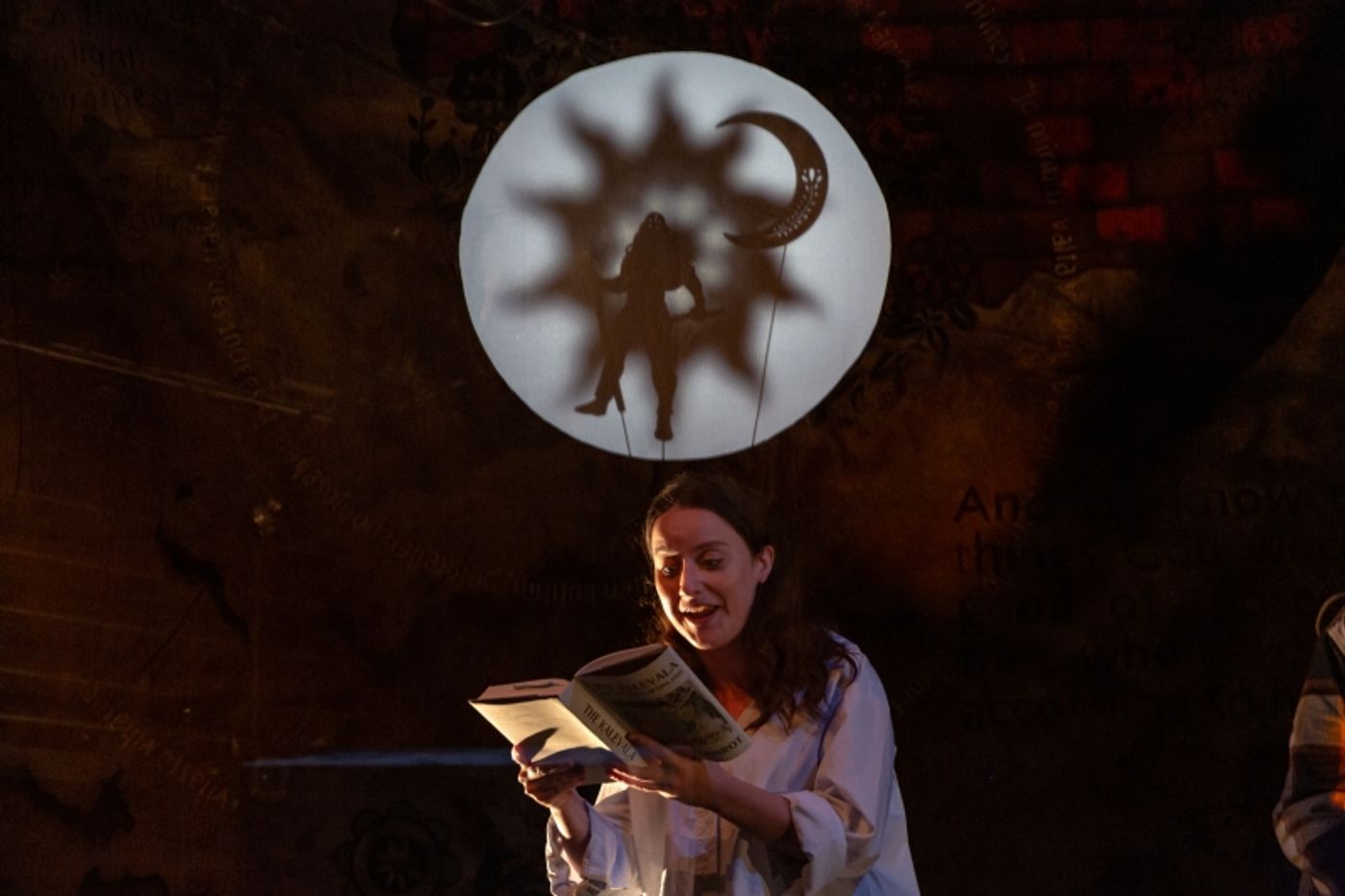Review: NEXT STAGE FESTIVAL: PART 1 at Buddies In Bad Times
Reviews of Gemini, This Feels Like the End, and The Noose


Welcome to the Next Stage Theatre Festival! Until Sunday, October 27th, its shows will fill Buddies in Bad Times Theatre's cabaret and chamber spaces. The festival run by Toronto Fringe is in its 17th year, and it promises "a curated collection of six theatrical explorations of what it means to be ourselves in relation to our communities, society, and the universe that contains us all."
Stay tuned for BWW's coverage of the final three shows in the festival. The first three, below:
GEMINI
There’s a bar in the front and one in the back — appropriate, for a show named after twins. One is real and functioning in the Buddies in Bad Times cabaret space; the other is the set of Gemini, Louise Casemore’s tight two-hander about the relationship between bartender Julie (Casemore) and uber-regular Ben (Vern Thiessen), a kindly grump with little time for social mores whose one poetic novel shot to the bestseller list after being promoted by an influencer.
For its relatively mobility, Joel Bazin’s set looks almost as functional as the bar in the back. This adds to the show’s realism, abetted by Thiessen prowling through the audience during Ben’s book reading that bookends the multiple flashbacks, while Julie asks if she can tidy our used cups. Other than in the present, though, we’re flies on the wall of the otherwise deserted bar, witnessing long afternoon stretches where Ben is the only customer and the two shoot the breeze via Casemore’s sharp, witty dialogue.
That dialogue is worth the price of admission, neatly tying together running themes like Julie’s mixed feelings about her self-destructive and ailing mother, the difference between having a string of partners with epic highs and lows versus one lengthy, comfortable but muted relationship (Ben muses, “I’m tired of all my stories being about her”), and Ben and Julie’s growing codependence, represented by their inability to complete crossword puzzles without each other.
The clever writing is ably assisted by strong performances by Casemore and Thiessen under Chantelle Han and Mitchell Cushman’s direction, filled with small details like how we see Julie progress from strictly pouring Maker’s Mark into shot glasses to measure Ben’s constant doubles, to simply eyeballing it into the glass as they grow comfortable with each other. Other delights are the running theme of the perpetually changing business next door, which juxtaposes with the seeming constancy of Ben and Julie’s relationship, and the fragmented timeline (that admittedly causes a bit of confusion near the end) partially due to Julie’s penchant for celebrating holidays at random and out of order.
GEMINI is a show where reading the author’s note first may actually hamper the experience, because it presents the show as an exploration of how inherently selfless people can do horrible things in a way that seems sudden and incongruous, which indicates a different goal than what’s highlighted on stage. Because of its structure, and especially in the post #MeToo era (the play was first produced in 2017), it’s hard not to see, as Ben puts it, “The inevitability of where this is going.”
Julie grows increasingly obsessed with Ben’s novel, trying to reconcile its poetry with the sardonic heavy drinker behind it. In this vein, the play also seems to ask us to conflate poetry, artistic talent, and human insight with goodness, a mistake that many vulnerable people are increasingly less likely to make. The present colours all of Ben’s actions in the past, presenting a story that’s more gray than the purported twins of black and white.
But there’s a lot to chew on here, especially in the gulf of understanding between Ben and Julie about what it means to be a woman in the service industry, where youth is currency, kindness tends to come with strings attached, and the body is for sale in subtle and not-so-subtle ways.
Photo of Vern Thiessen and Louise Casemore by Marc Chalifoux
THIS FEELS LIKE THE END

In Bonnie Duff’s one act, as Arthur C. Clarke famously wrote, “Overhead, without any fuss, the stars were going out.” After an intriguing opening image (scenic designer Meredith Wolting), where a shadow-puppet fox mysteriously appears inside a glowing circle, we’re presented with what happens when the sun, without fanfare or warning, seems to extinguish itself. It seems like the end of all things, but oddly, despite the world being plunged into darkness, the moon and aurora borealis are still visible and the plants are still growing. Faced with eternal night, no answers, and a lack of imminent demise, the world’s population resolutely carries on as normal.
While Duff’s play is in part a clear and obvious COVID metaphor—characters panic over diminishing resources and a potential future inability to breathe, mourn the lives they once had, grasp at straws of faith, and bemoan still having to turn assignments in while the literal sun has been blotted out—it’s not just a stand-in for the pandemic that turned our lives upside down, taking a look at some of the specific effects of solar deprivation and the sun’s place in the human story. However, the level of remove the metaphor provides may also help one process lingering feelings about the pandemic without feeling too on-the-nose or didactic. It helps that the characters are nuanced and believable, and that Duff is adept at cleverly creating scenarios to show how their fates are intertwined in increasingly complex ways.
Emmi (Duff), a reporter of Finnish heritage, travels to Finland to ask Laplanders how the people of the Midnight Sun process months of darkness, in light of the current conditions wherein that light might never return. She discovers age-old legends of a similar occurrence, delivering a thoughtful monologue where she wonders if they’re more than just stories. Her boyfriend Jamie (Landon Nesbitt, coming memorably unhinged as he increasingly wonders how everyone can just keep living) copes poorly with being left by himself, and begins to search for answers in unusual places. A “former sinner” turned street preacher (Cameron Laurie, playing a character reminiscent of his recent turn in Heroes of the Fourth Turning) drags a literal cross around while begging his fellow citizens to repent their ways, given this sign from God.
Therapist Sandy (Tara Koehler) consoles clients while wondering how her 9-year-old child (Jasmine Case) is coping; young Robin initially appears resilient, unaware of the larger repercussions of what has happened, but her patchy understanding of things leads to anxiety. Case’s excitable confusion is both poignant and charming; one scene, where she rushes to store oxygen in jars “just in case,” provokes reflection on how many times lately it’s seemed impossible to breathe. Director Michelle Blight’s choice to use largely practical lighting (designed by Mathilda Kane) adds charm to the proceedings while making the characters’ predicament seem more realistically claustrophobic, and Jake Schindler’s sound design adds rhythm to scene transitions and emotion to Emmi’s musings.
Duff’s ending, while impactful, is a little too ambitious in its tragic confluence to fully land, largely because the major dramatic question of the play and its structure are at odds with the abrupt resolution. After all, this is a show that works best when it’s exploring the aftermath of tragedy, rather than the moment it occurs, and when it asks how we’ll cope with having to carry on if things never return to the way they were.
Photo of Bonnie Duff by Barry McCluskey
THE NOOSE

Spending three years in a dingy basement with a single bare bulb hanging overhead, two Haitian immigrants try to coexist while making a living in New York. In director Abigail Whitney’s production of THE NOOSE, the odd couple, a middle-class intellectual and a lower-class illiterate, frustrate each other to the point of near madness. Polydor (Edmond Clark) is regularly upset by what he deems Pyram’s (Louco St. Fleur) posturing, mooching, and lack of education or curiosity; Pyram returns his ire at Polydor’s constant criticism and lugubrious philosophical musing in lieu of a real job. One left Haiti after clashing with the powers that be, and the other left to provide for a large, dependent family; both are ground down by a system where people walk by or overhead without giving men of their ethnicity a second thought.
Playwright Frankétienne, one of Haiti’s most famous writers and a Nobel Prize nominee, wrote THE NOOSE in 1978 in Haitian Creole as Pèlin Tèt, or “Head Trap.” This production provides a unique opportunity to see the work performed in English, a language in which it’s reportedly not been produced since 1997, when the translation by Dr. Asselin Charles was written. (Somewhat ironically, Pyram spits that he has no desire to learn the language, as nobody would make an effort to listen to him, anyway.)
The text in the play is expansive, with Frankétienne giving Polydor an almost Shakespearean cadence. Clark does his best sneering Iago at St. Fleur’s back, particularly in an unrelenting opening monologue where he brutally picks apart every detail of Pyram’s boasting story of a sexual conquest at Union Station. While Clark makes a delightful feast of Polydor’s words, St. Fleur is looser and freer, but shows greater range as a man becoming more and more downtrodden under the weight of manual labour.
Alana Raymond’s sound design also produces weight and tension, with the booming, distorted sounds of footsteps on metal overhead and muffled laughter in the dark. Set designer Matthew Hall approximates a late 1970s basement, with two twin bed areas decorated to character, and Costume Designer Kalina Popova differentiates their styles clearly, Polydor’s businesslike neutrals fading beside Pyram’s peacocking blue and purple shirt.
Pacing is a funny thing in a one act, and THE NOOSE suffers a bit in its middle third. In a two-hander where the characters must rile each other up to a climactic point without outside influence, there are two good options, either following the unity of time for a blistering 90 minutes or brute-forcing a longer passage of time through several short scenes. THE NOOSE is somewhere in between, not quite having enough spacing to denote a lengthy passage of time, while drawing out the time presented so it doesn’t quite seem like an explosive culmination of the two men’s coexistence. The fact that the impressive dialogue also moves in circles around the characters like the titular noose doesn’t help much. However, a late discovery and a growing understanding between the two men help to kick things into high gear toward the conclusion.
Next Stage presents a unique chance to see this rarely-performed touchstone of Haitian literature, so don’t wait another 27 years to see it.
Photo of Edmond Clark and Louco St. Fleur provided by the company
Reader Reviews
Videos

